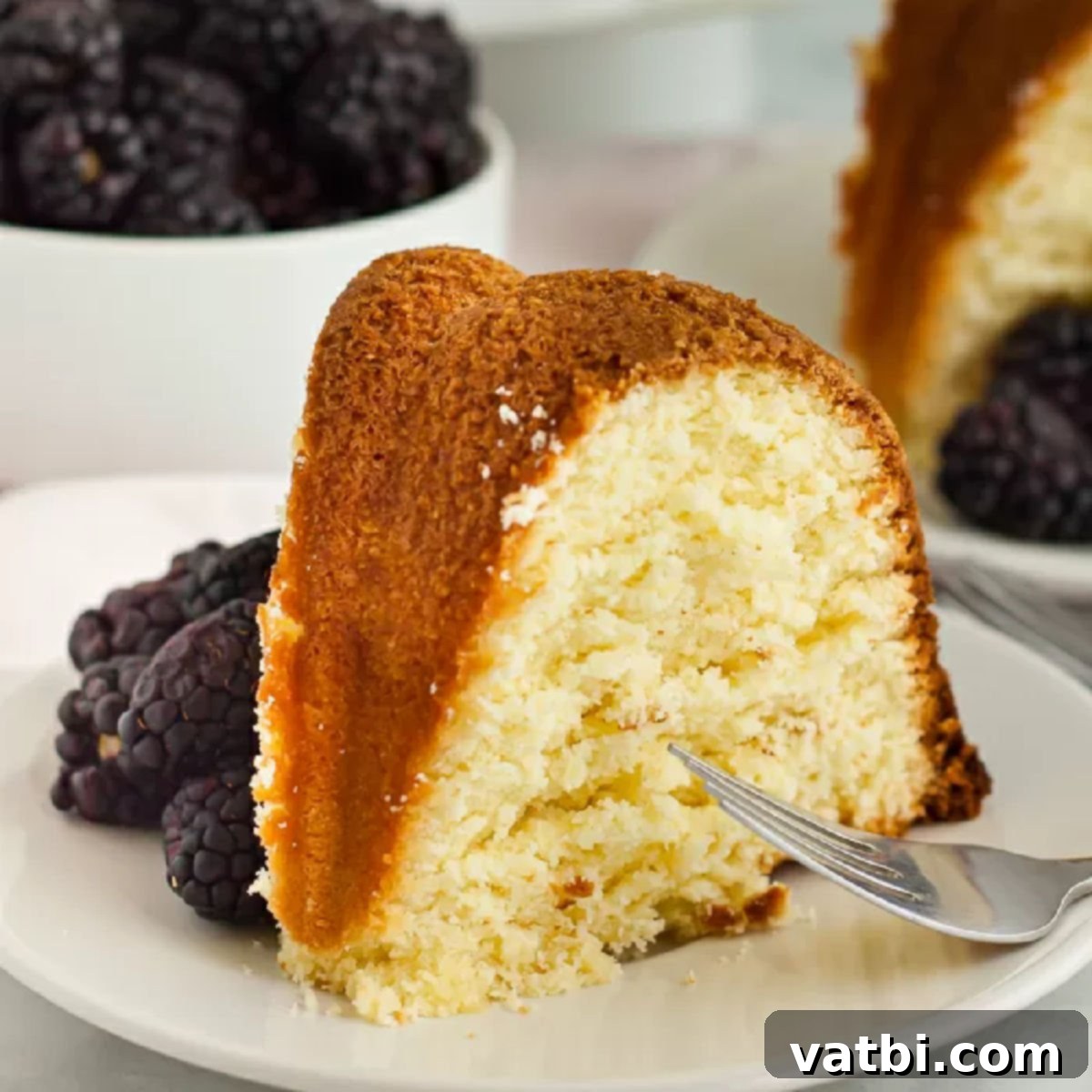Mastering the Classic Easy Pound Cake Recipe: Your Guide to a Moist, Homemade Delight
There’s nothing quite like a slice of classic pound cake – simple, elegant, and utterly delicious. This Easy Pound Cake Recipe is incredibly straightforward to make, requiring just a handful of basic ingredients that you likely already have in your pantry. It consistently delivers a luscious, moist, and dense cake that wins over everyone who tries it. My entire family adores this cake, especially when served with a vibrant medley of fresh berries and a dollop of fluffy whipped cream. It’s a timeless dessert that never goes out of style and is perfect for any occasion, from a casual family dinner to a festive gathering.
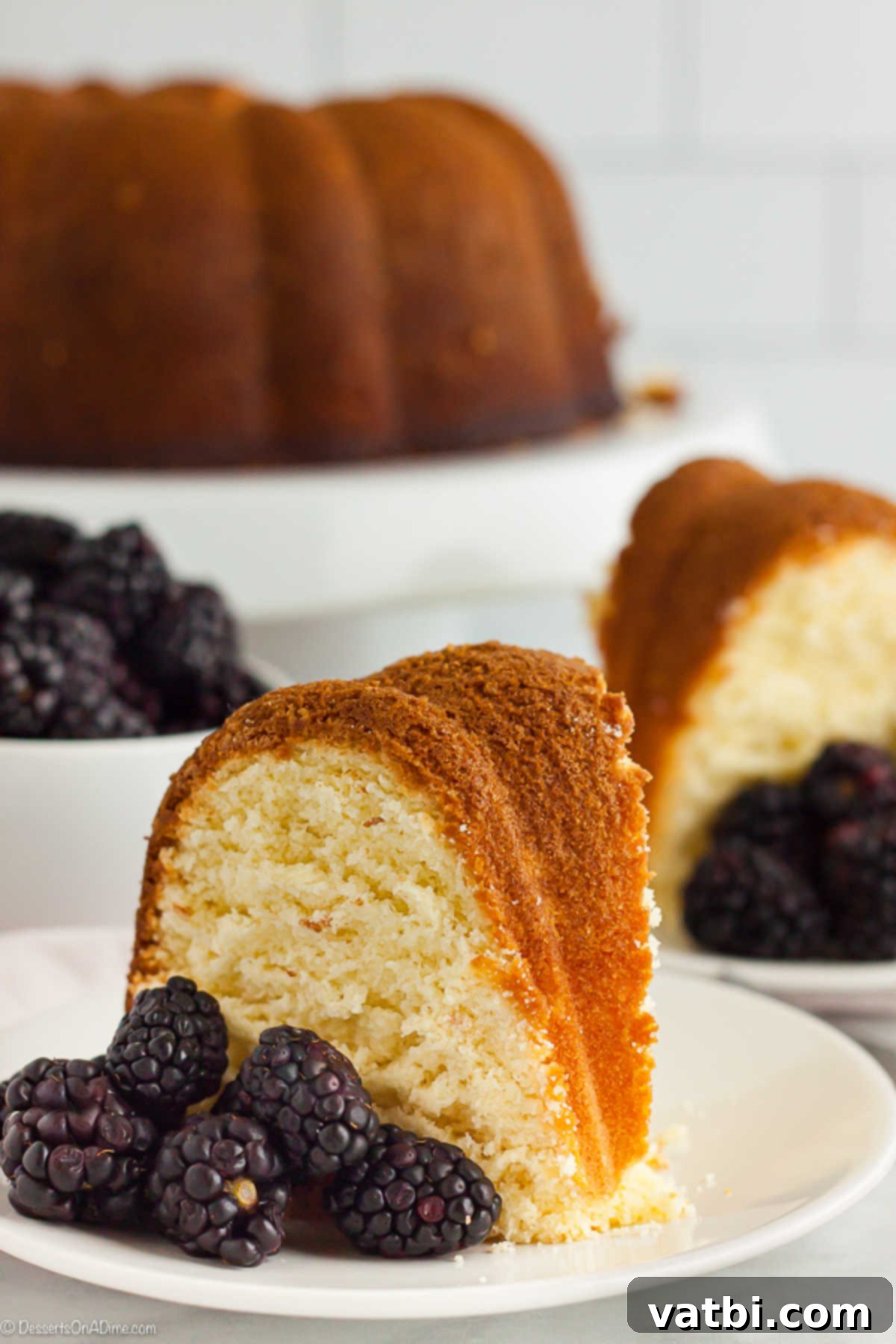
This classic dessert is often overshadowed by more elaborate creations, but its enduring popularity speaks volumes about its comforting appeal. The beauty of this easy pound cake recipe lies in its simplicity. It’s a wonderful canvas for various flavors and toppings, making it incredibly versatile. If you’re looking to explore other delectable cake options, consider trying our Chocolate Pound Cake for a rich, cocoa-infused twist. For something lighter and airier, our Angel Food Cake Recipe is a fantastic choice, or for a seasonal treat, you can’t go wrong with our Apple Bundt Cake. But for pure, unadulterated classic comfort, this homemade pound cake stands in a league of its own.
Table of contents
- Why is a Pound Cake called a Pound Cake?
- Pound Cake Vs Bundt Cake
- Essential Ingredients for the Perfect Pound Cake
- Variations and Additions
- How to Make a Pound Cake from Scratch
- Expert Tips for Pound Cake Perfection
- Frosting Ideas
- Toppings
- Storage
- FAQs
- More Easy Cake Recipes
Why is a Pound Cake Called a Pound Cake?
The name “Pound Cake” has a charming historical origin, stemming directly from its traditional ingredient list. A true, classic pound cake recipe was originally a four-ingredient wonder, calling for a pound of each essential component: flour, sugar, butter, and eggs. This simple, balanced ratio produced a remarkably dense, rich, and flavorful cake that became a household staple. Over centuries, bakers have experimented with and refined this basic formula, introducing variations to enhance texture, moisture, and flavor. While modern pound cake recipes might not strictly adhere to the “pound of each” rule (often including leavening agents or varying proportions to achieve a lighter crumb), the name has stuck, honoring its humble, robust origins. The essence of a pound cake, however, remains its characteristic density, fine crumb, and buttery richness.
For more delicious variations on this classic, be sure to explore all our Pound Cake Recipes.
Pound Cake Vs Bundt Cake
It’s a common misconception that pound cakes and Bundt cakes are interchangeable, but there’s a distinct difference between the two. While many pound cakes are indeed baked in a Bundt pan, the terms describe different aspects of a cake:
- Pound Cake: This term refers to a specific *type* of cake. It’s known for its rich, dense, heavy, and moist texture, often made without chemical leavening agents (like baking powder or soda) in its most traditional form. Its structure comes primarily from the creaming of butter and sugar and the volume of eggs.
- Bundt Cake: This term describes a cake that is baked in a Bundt pan. A Bundt pan is a specialized baking pan with a distinctive fluted or grooved shape, often with a hole in the center. While a pound cake can certainly be a Bundt cake if baked in that particular pan, any cake batter (like a chocolate cake, coffee cake, or even a simple vanilla cake) can be baked in a Bundt pan, making it a “Bundt cake” by shape, not by composition. The unique pan shape allows for more even baking and a beautiful presentation.
Essential Ingredients for the Perfect Pound Cake
Creating the best easy pound cake requires just a few high-quality ingredients. Each plays a crucial role in achieving that signature dense, moist, and tender crumb:
- Unsalted Butter: The star of any pound cake, butter provides richness, flavor, and contributes to the cake’s tender texture. Ensure it is softened to room temperature before using, as this is critical for proper creaming with sugar, which incorporates air and creates a light, fluffy base.
- Granulated Sugar: Not only does sugar add sweetness, but it also helps keep the cake incredibly moist. When creamed with butter, it creates air pockets essential for the cake’s structure and rise.
- Large Whole Eggs & Large Egg Yolks: Eggs provide structure, richness, and emulsification. The additional egg yolks contribute extra fat, resulting in a more tender, moist, and golden crumb. Make sure they are also at room temperature for optimal blending.
- Pure Vanilla Extract: A crucial flavor enhancer, vanilla extract adds warmth and depth, complementing the rich buttery notes. Opt for pure vanilla extract over imitation for the best taste.
- Salt: A pinch of salt balances the sweetness and enhances all the other flavors, preventing the cake from tasting flat.
- All-Purpose Flour: While some pound cakes use cake flour for a finer crumb, good quality all-purpose flour works wonderfully, providing the necessary structure. Ensure you measure it correctly – ideally by weight or by lightly spooning it into a measuring cup and leveling it off – to avoid a dry or tough cake.
You can find the exact measurements for all these ingredients in the detailed recipe card at the very bottom of this post.
Variations and Additions for Your Pound Cake
While this classic pound cake recipe is perfect as is, it’s also wonderfully adaptable! Don’t hesitate to get creative and customize it to your taste:
- Infuse with Flavored Extracts: Easily switch up the flavor profile by using a different extract. Lemon extract provides a bright, zesty note, almond extract offers a sophisticated, nutty aroma, and mint extract can create a refreshing twist. Explore other options like coconut, rum, or even a hint of maple.
- Add Citrus Juice and Zest: For an incredibly fresh and vibrant flavor, incorporate fresh citrus. To make a lemon pound cake, fold in the finely grated zest of one or two lemons along with a few tablespoons of fresh lemon juice into the batter. Orange or lime zest and juice can create equally delightful variations, adding a tangy brightness that cuts through the richness of the cake.
- Stir in Chocolate Chips, Nuts, or Fruit: Enhance the texture and flavor by mixing in your favorite add-ins to the cake batter.
- Chocolate Chips: Try semi-sweet, dark, milk, or even white chocolate chips for a sweet surprise.
- Chopped Nuts: Toasted pecans, walnuts, or almonds add a lovely crunch and nutty flavor.
- Fresh or Dried Fruit: Blueberries, raspberries, cranberries, or even mashed bananas can be folded into the batter. If using fresh fruit, toss them lightly in a tablespoon of flour first to prevent them from sinking to the bottom of the pan. Diced apples with a touch of cinnamon also make a fantastic autumn pound cake.
How to Make a Pound Cake from Scratch
Baking a perfectly moist and flavorful pound cake from scratch is easier than you might think. Follow these step-by-step instructions for a guaranteed success:
- Step 1: Prepare Your Pan and Oven. Begin by preheating your oven to 350°F (175°C). This ensures the oven is at the correct temperature when the cake goes in, preventing uneven baking. Next, generously grease and flour a 10-inch Bundt pan or tube pan. This crucial step prevents the cake from sticking. Make sure to tap out any excess flour. As an alternative, a baking spray with flour can also be used. Set the prepared pan aside.
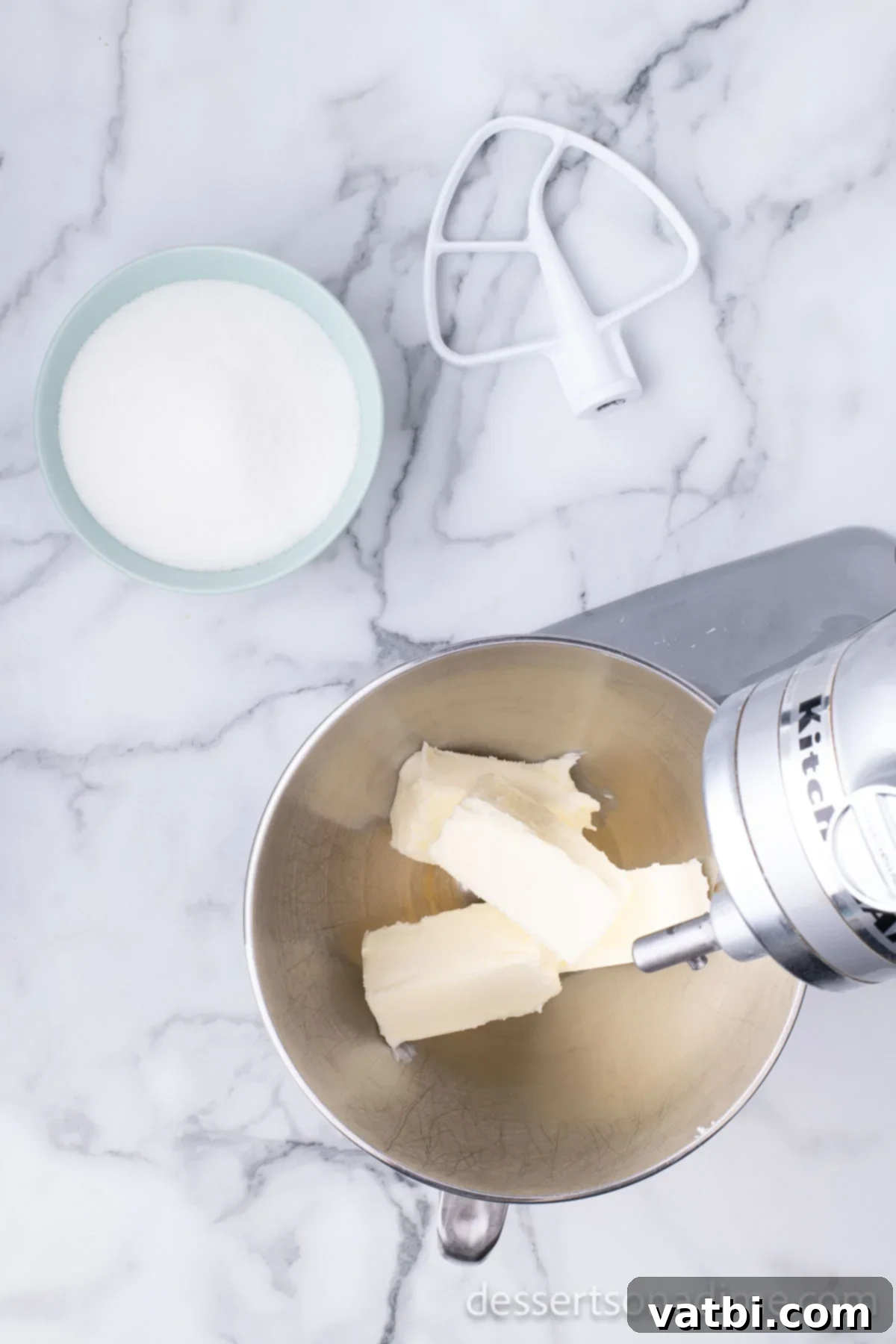
Step 2: Start Creaming the Butter. Place your softened unsalted butter into the bowl of a stand mixer fitted with the paddle attachment. If you don’t have a stand mixer, a hand mixer will work just as well.
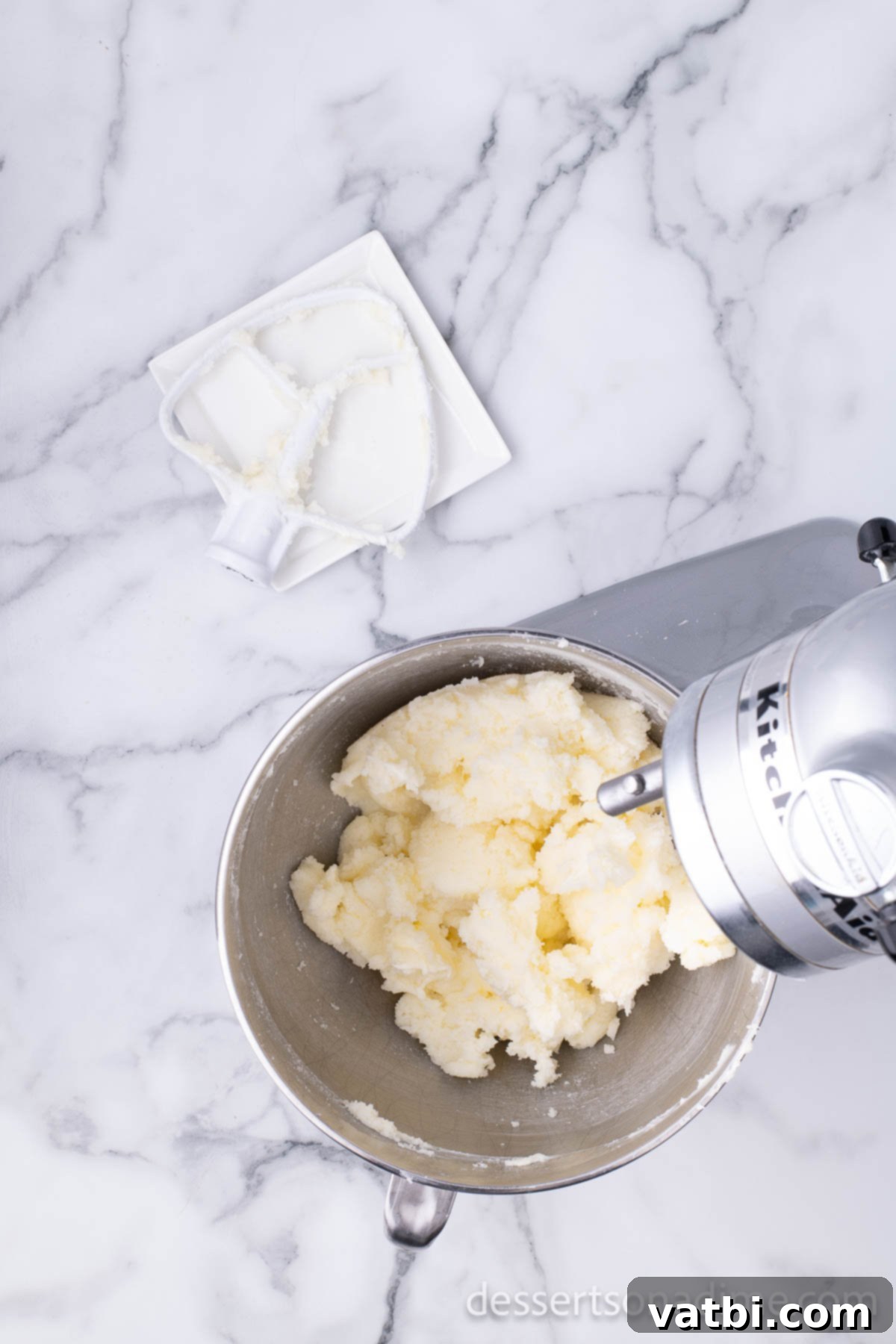
Step 3: Cream Butter and Sugar. Beat the butter on medium speed until it is creamy and smooth, about 1-2 minutes. Then, scrape down the sides of the bowl to ensure everything is evenly mixed. Gradually add the granulated sugar to the butter. Continue beating on medium-high speed for another 2-3 minutes, or until the mixture is light, fluffy, and pale in color. This creaming process incorporates air, which is vital for the cake’s tender texture.
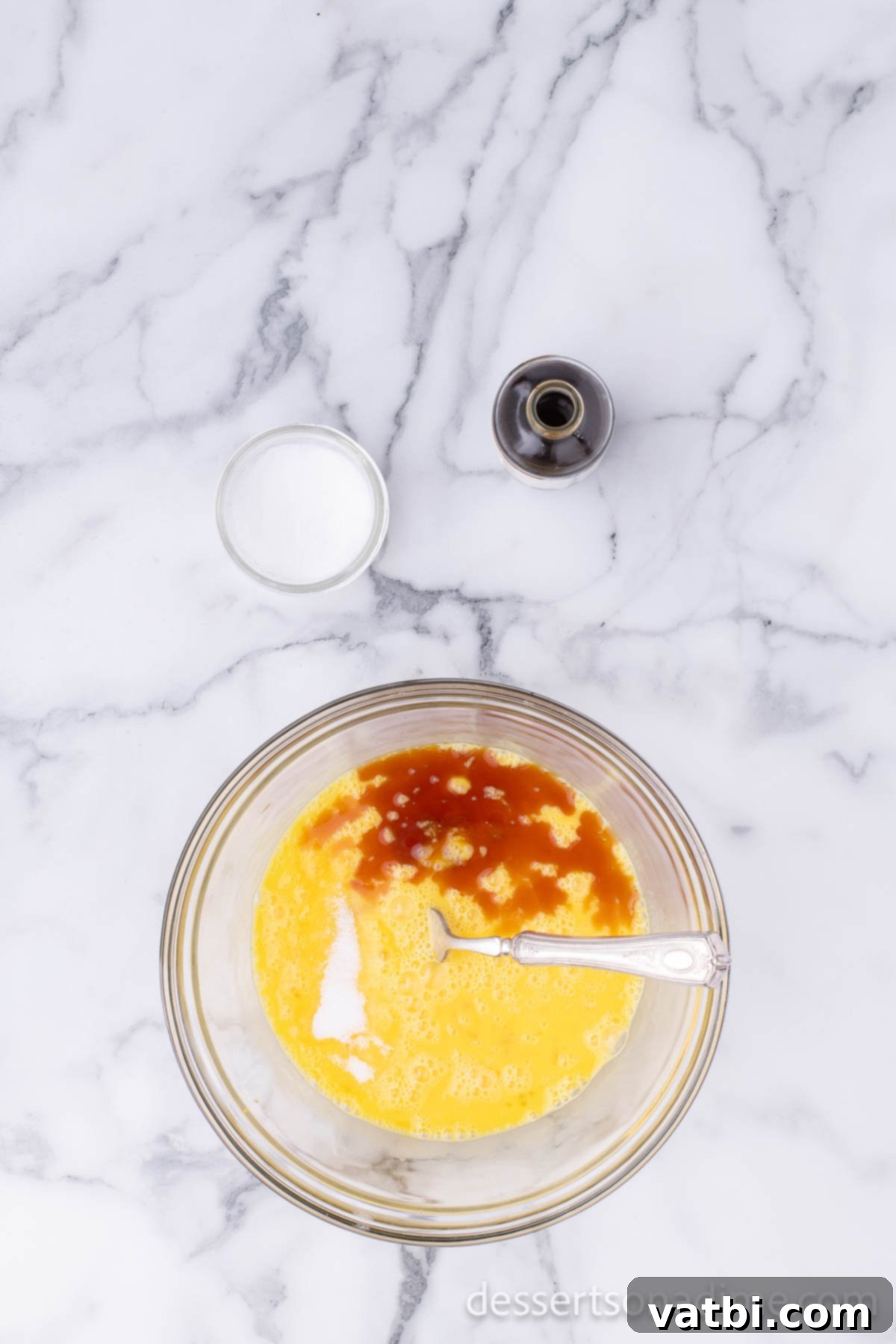
Step 4: Prepare the Egg Mixture. In a separate, medium-sized bowl, combine the large whole eggs, egg yolks, vanilla extract, and salt. Use a fork to lightly beat them until the yolks are broken up and the ingredients are just combined. This ensures they are evenly distributed when added to the batter.
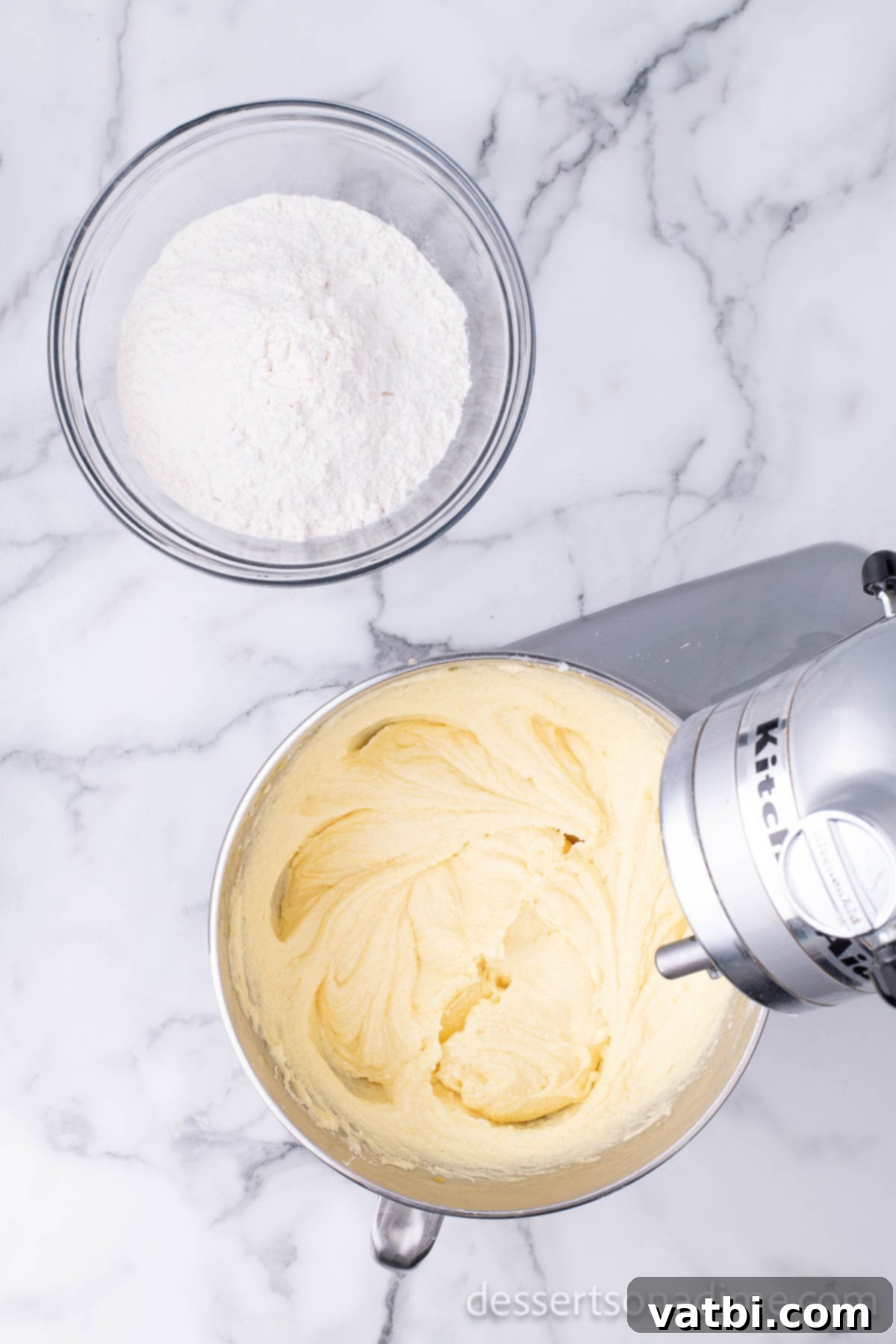
Step 5: Gradually Add Eggs and Flour. With your mixer on low speed, slowly pour the egg mixture into your butter and sugar batter, allowing it to incorporate gradually. This prevents the batter from curdling. Once the egg mixture is fully incorporated, scrape down the sides and bottom of the bowl. Then, with the mixer still on low speed, gradually add the all-purpose flour, about ½ cup at a time, until it is just combined. Avoid overmixing.
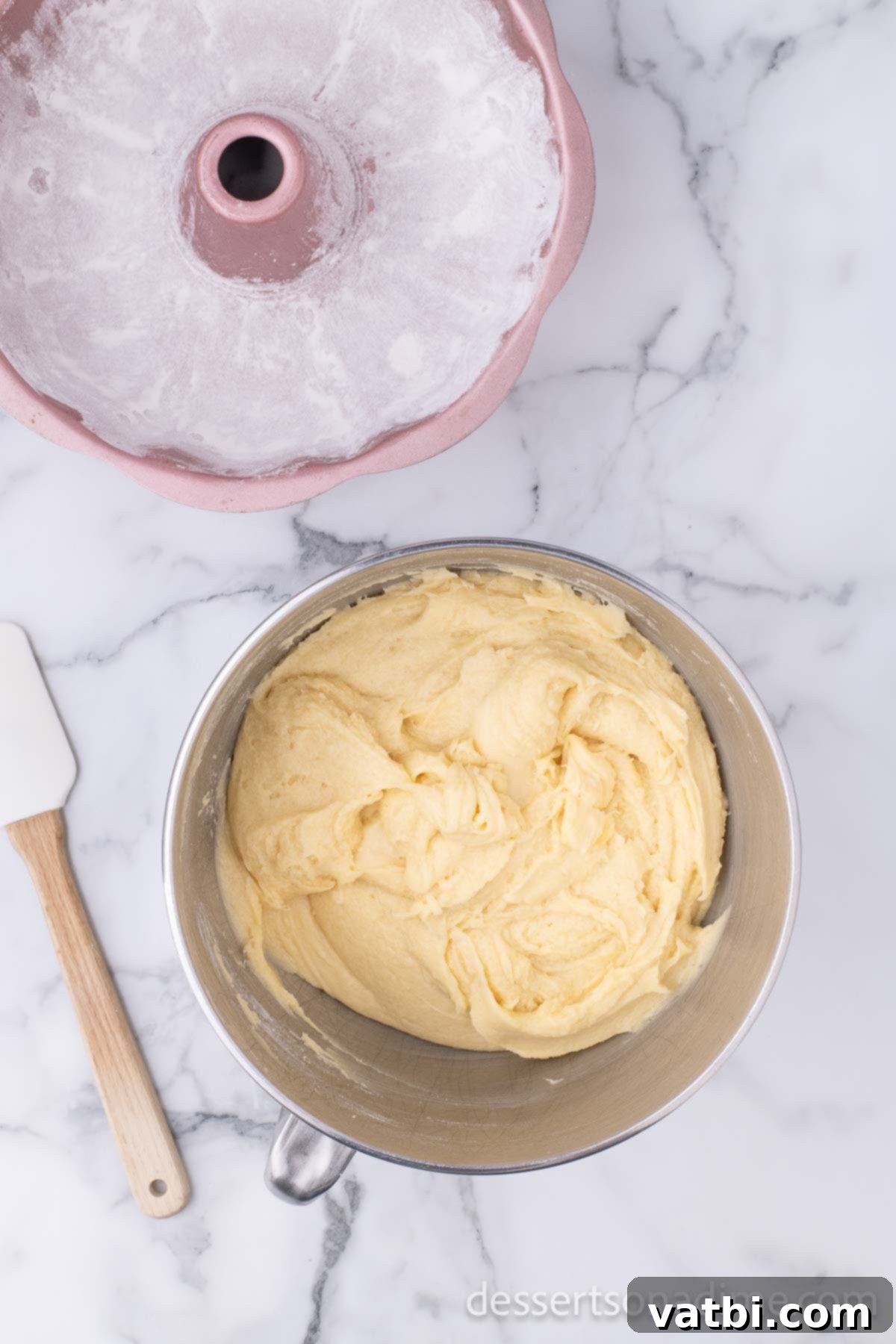
Step 6: Final Mix. After all the flour has been added, scrape down the sides and bottom of the bowl one last time. Beat on medium speed for just one more minute to ensure everything is well combined without overdeveloping the gluten.
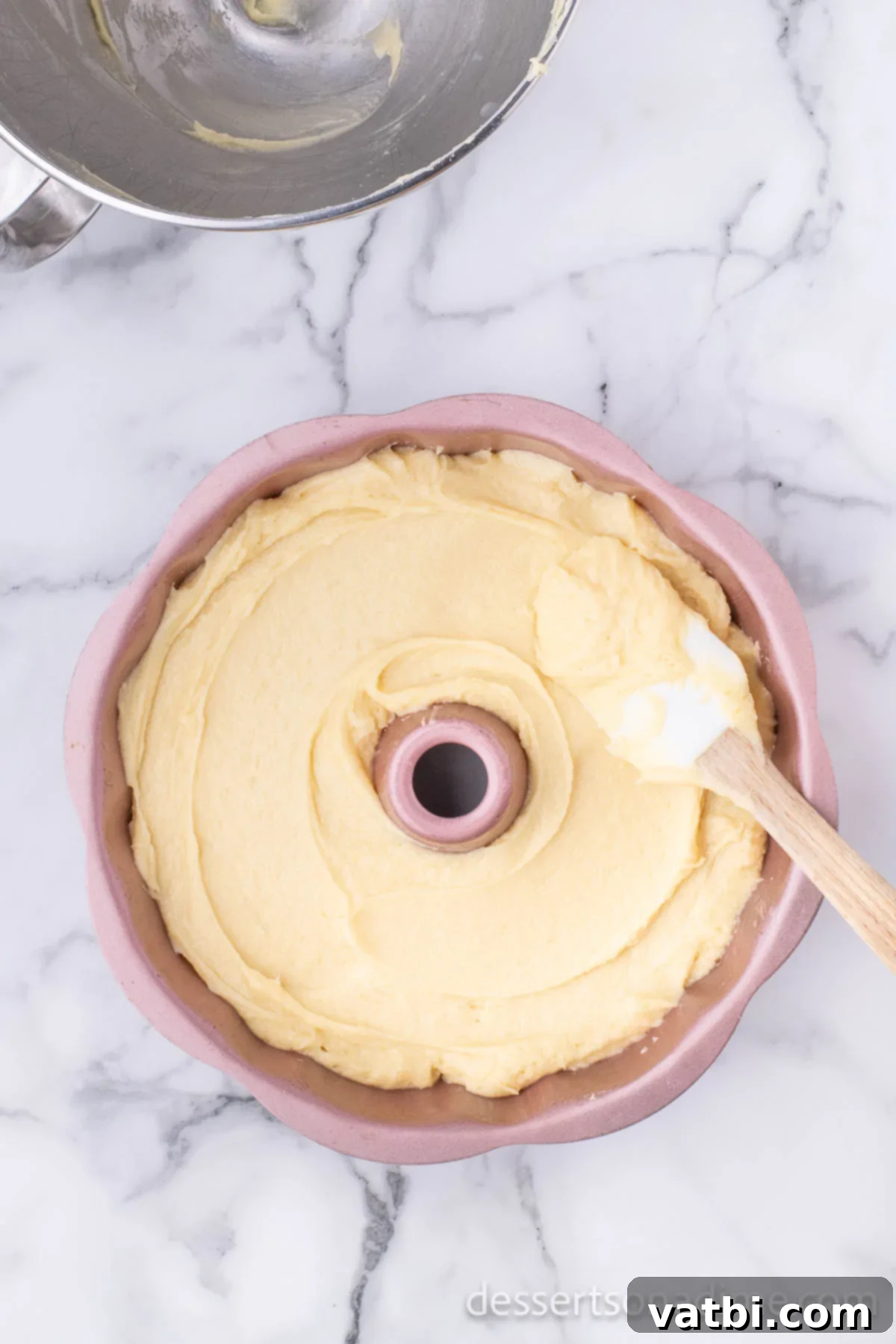
Step 7: Fill the Pan. Your rich pound cake batter is now ready for baking! Carefully spread the batter evenly into the prepared Bundt pan. Use a spatula to smooth the surface of the batter, ensuring it’s distributed uniformly, which helps with even rising.
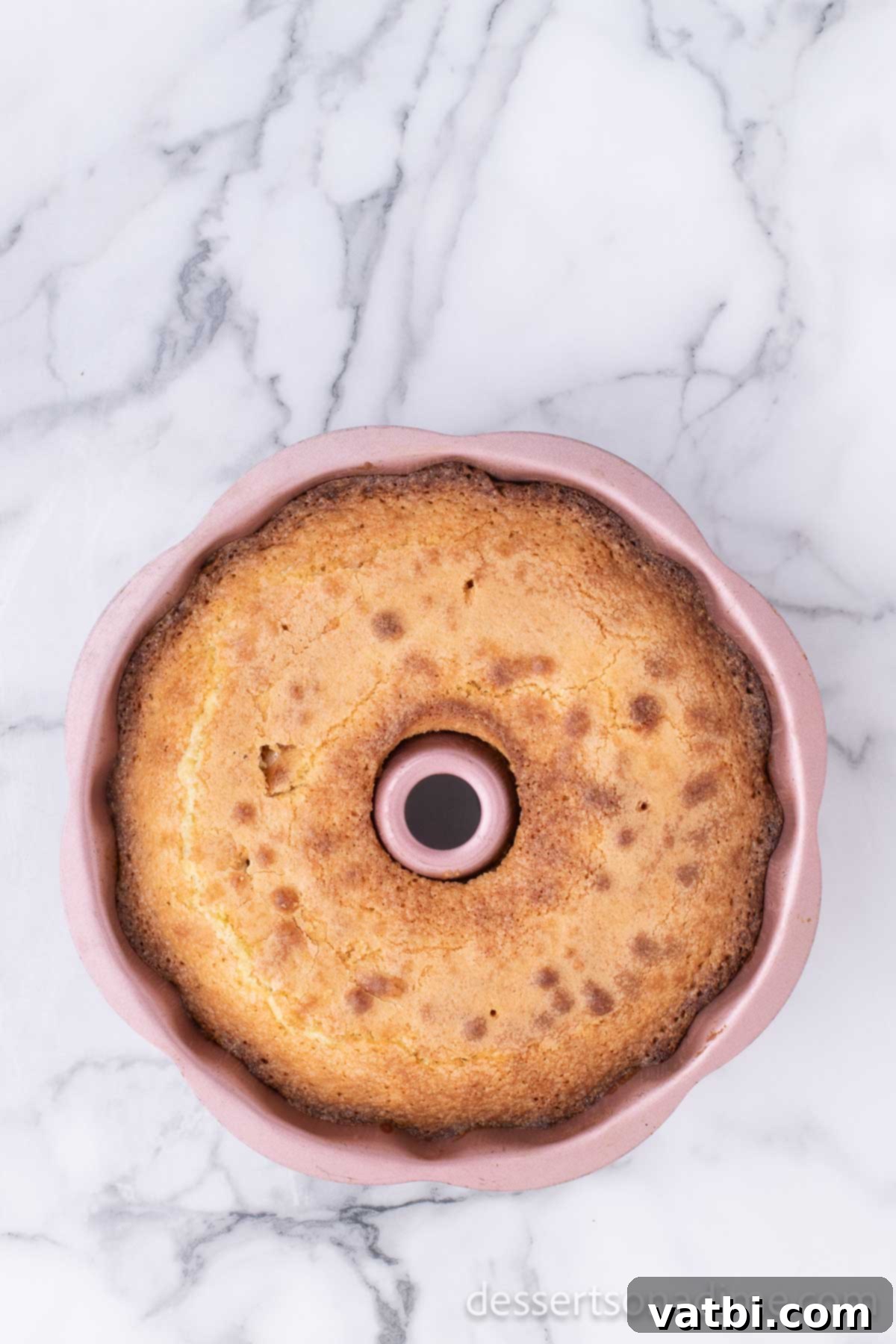
Step 8: Bake to Perfection. Bake at 350°F (175°C) for approximately 60-75 minutes. The baking time can vary depending on your oven, so check for doneness by inserting a toothpick into the center of the thickest part of the cake. If it comes out clean, the cake is ready. Avoid overbaking, as this can lead to a dry cake.
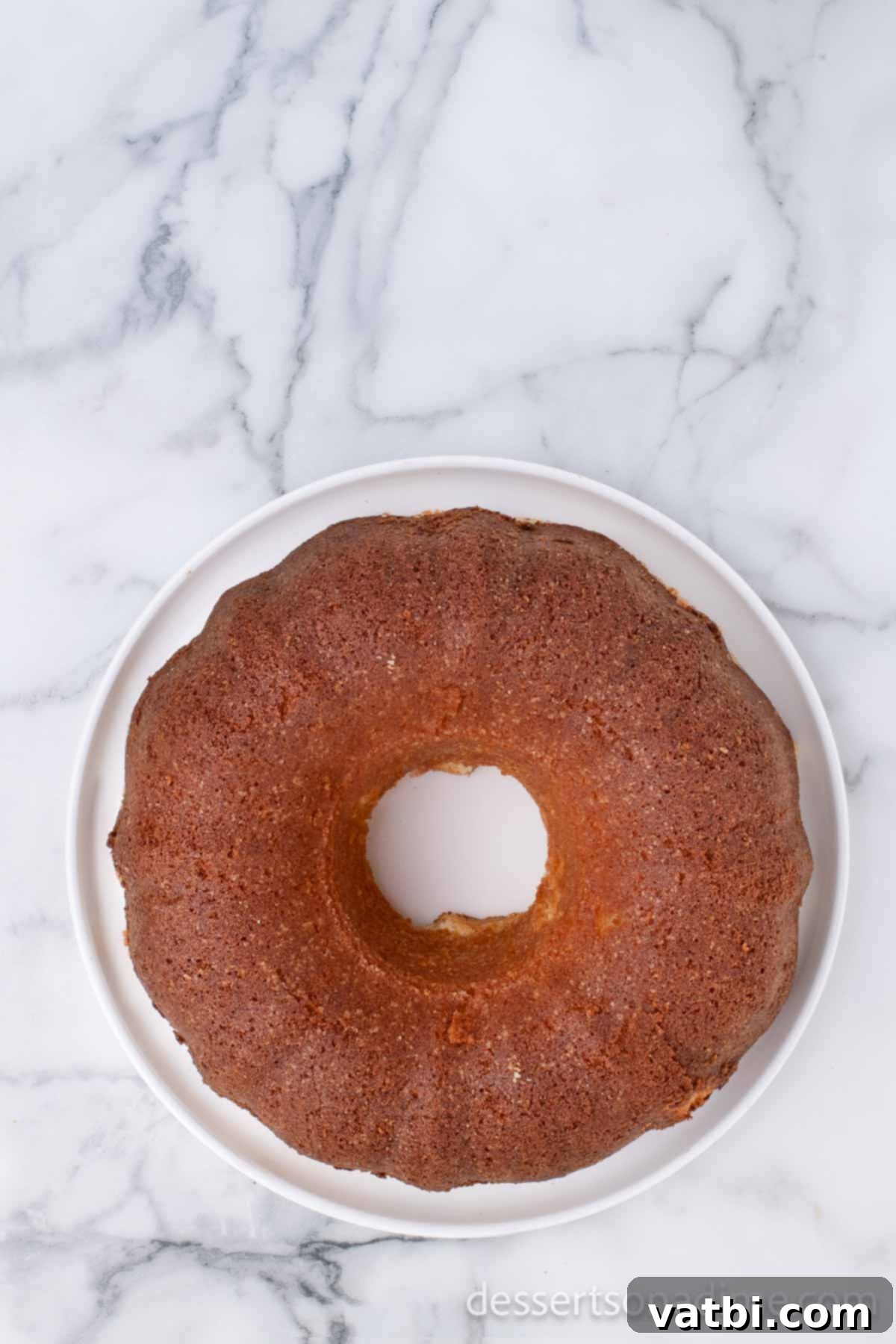
Step 9: Cool and Serve. Allow the baked pound cake to cool in its pan for at least 15-20 minutes. This allows the cake to firm up slightly, making it easier to remove. After cooling in the pan, run a thin knife around the sides of the Bundt pan and the center tube to loosen the cake. Carefully invert the pound cake onto a wire cooling rack and let it cool completely before slicing and serving. Cooling completely is important for the cake’s final texture and flavor development.
Expert Tips for Pound Cake Perfection
Achieving a truly remarkable homemade pound cake involves a few key techniques and considerations. Keep these expert tips in mind for the best results every time:
- Use Room Temperature Ingredients: This is arguably the most important tip! Butter, eggs, and any dairy (if your recipe includes it) should be at room temperature. This allows them to emulsify properly, creating a smooth, cohesive batter that traps air more effectively, leading to a lighter, more uniform crumb and better rise. Cold ingredients will result in a lumpy batter and a dense cake.
- Softened, Not Melted Butter: Ensure your butter is softened to room temperature – pliable but still cool to the touch. Do not use the microwave to soften butter, as even slightly melted butter will prevent proper creaming with sugar. Melted butter will cause the cake to be dense and flat, lacking the tender crumb characteristic of a good pound cake.
- Avoid Overmixing: Once you add the flour, mix only until the ingredients are just combined. Overmixing develops the gluten in the flour, leading to a tough, dry, and chewy cake rather than a tender one. Excessive mixing can also cause air bubbles to escape, resulting in a dense cake that might crack during baking. Precise measuring with a kitchen scale can also help prevent issues.
- Opt for Real Butter: For the most superior flavor and texture, I highly recommend using high-quality real butter (not margarine or butter substitutes) in this recipe. The richness of real butter is central to the classic pound cake experience.
- Sift Your Flour: For an extra light and airy crumb, consider sifting your all-purpose flour before adding it to the batter. This breaks up any lumps and aerates the flour, contributing to a finer texture in the finished cake.
- Know Your Oven: Oven temperatures can vary significantly. Using an oven thermometer can help ensure your oven is consistently at the correct temperature, which is vital for even baking and proper rising.
- Cool Properly: Allow the cake to cool in the pan for the recommended time (typically 15-20 minutes) before inverting it onto a cooling rack. This allows the cake to set and prevents it from breaking when removed from the pan. Cooling completely on a rack is also important for moisture retention and texture.
Frosting Ideas for Your Pound Cake
While a simple dusting of powdered sugar or a fresh fruit topping is often all a good pound cake needs, adding a delicious frosting can elevate it to a truly decadent dessert. Here are a few of our favorite frosting recipes that pair beautifully with this classic cake:
- Cream Cheese Frosting: A tangy, sweet, and incredibly smooth frosting that adds a wonderful contrast to the rich pound cake. It’s a perennial favorite for a reason!
- Peanut Butter Frosting: For those who love a rich and nutty flavor, this frosting adds a unique and satisfying twist. It’s surprisingly versatile and utterly delicious.
- Marshmallow Frosting: Light, fluffy, and perfectly sweet, marshmallow frosting creates a beautiful, ethereal topping that feels both nostalgic and gourmet.
- Buttercream Icing: A classic choice, homemade buttercream is smooth, rich, and can be flavored in countless ways. It provides a luxurious finish that complements the pound cake’s buttery notes.
Delicious Toppings for Your Pound Cake
One of the joys of a simple pound cake is its versatility with toppings. Here are some fantastic ideas to enhance your classic easy pound cake:
- Whipped Cream and Berries: This is a quintessential pairing. The light, airy sweetness of Homemade Whipped Cream beautifully complements the dense cake, while fresh berries (strawberries, blueberries, raspberries, or blackberries) add a burst of juicy, tart freshness and vibrant color.
- Ice Cream: For a truly indulgent treat, especially during warmer months, serve slices of pound cake with a scoop of your favorite ice cream. Our No-Churn Strawberry Ice Cream is a perfect match, offering a creamy, fruity contrast. Vanilla bean, chocolate, or even a rich caramel ice cream would also be delightful.
- Fruit Compotes or Sauces: A warm fruit compote made with seasonal fruits like peaches, cherries, or mixed berries can add a sophisticated touch. A raspberry coulis or a simple lemon curd also work beautifully, providing a tangy counterpoint to the cake’s richness.
- Chocolate Ganache or Drizzle: For chocolate lovers, a silky smooth chocolate ganache poured over the cooled cake, or a simple chocolate drizzle, adds an elegant and decadent finish.
- Citrus Glaze: A simple glaze made from powdered sugar and lemon or orange juice can add a sweet, tart finish and a lovely sheen to the cake, reinforcing any citrus flavors in the batter.
- Powdered Sugar Dusting: Sometimes, less is more. A light dusting of powdered sugar is an understated yet elegant way to finish your pound cake, letting its natural beauty and flavor shine through.
Storage Tips for Your Homemade Pound Cake
Proper storage is key to keeping your delicious pound cake fresh and moist for as long as possible:
Store any leftover pound cake in an airtight container at room temperature for up to 5 days. For individual slices, separating them with parchment paper can prevent sticking and make them easier to grab. Avoid refrigerating pound cake unless it has a perishable frosting, as the refrigerator tends to dry out cakes. If you do need to refrigerate, ensure it’s tightly wrapped.
For longer storage, pound cake freezes beautifully. To freeze, wrap the cooled cake tightly first with plastic wrap, then with aluminum foil. Place it in a freezer bag or an airtight freezer-safe container. It can be frozen for up to 3-6 months. When you’re ready to enjoy it, simply remove it from the freezer and let it sit at room temperature to thaw completely before unwrapping and serving. This slow thawing process helps maintain its moisture and texture. For more detailed instructions on freezing, check out our guide on Can You Freeze Pound Cake.

Frequently Asked Questions About Pound Cake
For this pound cake recipe, I highly recommend using a 10-inch Bundt pan, which is often also referred to as a 12-cup Bundt pan. The intricate design of the Bundt pan not only gives the cake a beautiful, elegant shape but also helps with even heat distribution during baking, ensuring a perfectly cooked cake with a lovely golden crust. A standard tube pan can also be used, offering a slightly more traditional, straight-sided appearance.
Yes, absolutely! This versatile pound cake batter can be easily adapted for loaf pans. Instead of a single Bundt pan, pour the cake batter into two prepared 9×5-inch loaf pans. When baking in loaf pans, the cooking time will be shorter. Bake at 350°F (175°C) for approximately 50-60 minutes, or until a toothpick inserted into the center of a loaf comes out clean. Ensure the pans are adequately greased and floured.
The key to a truly moist pound cake lies in a few crucial factors. Firstly, do not reduce the amount of sugar, as sugar is a hygroscopic ingredient that attracts and retains moisture. The combination of sugar and a generous amount of eggs in this recipe contributes significantly to the cake’s moistness and richness. Secondly, avoid overcooking the cake; baking it for too long will inevitably lead to a dry texture. Keep a close eye on it during the last 15-20 minutes of baking. Lastly, and perhaps most importantly, do not overmix the batter, especially after adding the flour. Overmixing develops gluten, making the cake tough and dry.
The secret to baking the best pound cake lies in two fundamental principles: using room temperature ingredients and not overmixing your cake batter. Room temperature ingredients (especially butter and eggs) emulsify better, creating a smooth batter that incorporates and holds air effectively, resulting in a tender, even crumb. Overmixing, conversely, overdevelops gluten, leading to a tough, dry cake that lacks the desired light and airy texture characteristic of a perfect pound cake. Follow these two key points, and you’ll consistently bake a superior pound cake.
A common reason for a pound cake overflowing is overmixing the ingredients, particularly after the flour has been added. Overmixing can incorporate too much air into the batter, causing it to rise excessively and then potentially collapse or spill over during baking. It can also lead to an overly dense crumb which pushes the batter higher. Additionally, using a pan that is too small for the amount of batter can cause overflowing. Always ensure your pan is the correct size as specified in the recipe and mix only until combined.
The most reliable way to check for doneness is the toothpick test. Insert a clean toothpick into the center of the thickest part of the cake. If it comes out clean or with a few moist crumbs attached (but no wet batter), the cake is done. Other indicators include the cake pulling away slightly from the sides of the pan, the top springing back when gently pressed, and a golden-brown crust. Avoid opening the oven door too frequently during baking, especially in the first 45 minutes, as this can cause the cake to fall.
The “best” frosting for pound cake often comes down to personal preference! This versatile pound cake recipe pairs wonderfully with a variety of frostings. Classic choices like a simple powdered sugar glaze, a rich cream cheese frosting, or a traditional buttercream are always fantastic. For something different, consider a lemon glaze for a zesty kick, a chocolate ganache for decadence, or even a light whipped cream topping. Feel free to use your favorite homemade frosting or a quality store-bought option.
Several factors can cause a pound cake to fall in the middle. The most common culprit is often overbeating the batter, especially after adding the flour. This can introduce too much air or overdevelop gluten, creating a weak structure that cannot support the cake’s rise. Other reasons include opening the oven door too early during baking (causing a sudden temperature drop), an oven that is too cool or too hot (leading to uneven baking), or sometimes, simply underbaking the cake, which means the center hasn’t fully set. Ensure ingredients are at room temperature and follow mixing instructions carefully.
More Easy Cake Recipes You’ll Love
- Old Fashioned Hummingbird Cake
- Cream Cheese Puffs Recipe
- Hawaiian Wedding Cake
- Orange Pound Cake
- Lemon Pound Cake Recipe
- Easy S’Mores Cake Recipe
Now it’s your turn to experience the joy of baking this wonderful classic pound cake. Don’t forget to come back and leave a comment to share your delicious results!
Pin
Easy Pound Cake Recipe
Ingredients
- 2 cups unsalted butter softened
- 3 ½ cups granulated sugar
- 6 large whole eggs
- 6 large egg yolks
- 1 Tablespoon vanilla extract
- 1 teaspoon salt
- 3 1/2 cups all-purpose flour
Instructions
-
Preheat your oven to 350F and generously grease and flour a 10″ bundt pan. Shake out excess flour and set aside.
-
Place your butter in a standing mixer. Beat the butter until it is creamy and smooth.
-
Scrape down the sides of the bowl and add the sugar. Beat until the ingredients are well combined and light and fluffy (about 2 minutes).
-
In a separate, medium-sized bowl, combine your eggs, egg yolks, vanilla extract, and salt.
-
Use a fork to lightly beat the eggs until egg yolks are broken up and salt and vanilla are incorporated.
-
With mixer on low speed, slowly pour egg mixture into your batter, allowing it to mix together slowly.
-
Once all of the egg mixture is incorporated, scrape down the sides and bottom of the bowl, then increase speed to medium-high and beat for another 1-2 minutes.
-
Reduce mixer speed back to low and gradually, about ½ cup at a time, add flour to the batter until all has been added to the mixer.
-
Scrape down the sides and bottom of bowl and mix again on medium speed until well-combined for another minute.
-
Spread batter evenly into the prepared bundt pan. Use a spatula to smooth the surface of the batter on the top of the pan.
-
Bake for 60-75 minutes or until a toothpick inserted in the center of the thickest part of the cake comes out clean. Do not over bake.
-
Allow the cake to cool for at least 20 minutes then run a knife around the sides of the bundt pan and the center.
-
Carefully invert the pound cake onto a cooling rack and allow to cool completely before serving.
-
Slice and serve!
Nutrition Facts
Pin This Now to Remember It Later
Pin Recipe
